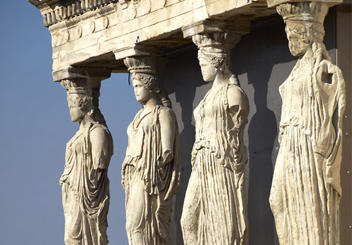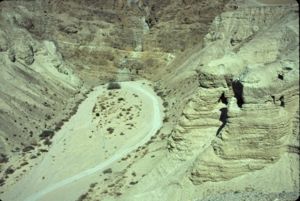Home » Dead Sea Scrolls » Introduction
Introduction
The Dead Sea Scrolls Most modern translations call this feast the feast of the Dedication. Its Greek name, Τά ’Εγκαίνια, means the ‘inauguration’ or ‘the renewal’, and this is a more literal rendering of the Hebrew hanukkah, the name which was given to the feast by the Rabbis and by which it is still known […]
The Dead Sea Scrolls I. The Greek Language in Palestinian Judaism a) The penetration of the Greek language into Palestine The bond which held the Hellenistic world together despite the fragmentation which began with the death of Alexander and continued thereafter, was Attic koinē. Its sphere of influence went far beyond that of Aramaic, the […]
The Dead Sea. Photo courtesy of BiblePlaces.com. The Dead Sea Region has traditionally been a place of refuge from mainstream society in Judea. Various dwellers and refugees left both their writings and their documents in the area. These manuscripts were preserved by the region’s dry climate and have come to be known as the Dead […]
The Dead Sea Scrolls DEAD SEA SCROLLS. The name given to deposits of ancient texts written in Hebrew, Aramaic, or Greek, on papyrus or leather, that since 1947 have been discovered near the W shore of the Dead Sea. This label is used in both a narrow and a broad sense. The narrow definition is […]
The Dead Sea Scrolls 538 BCE Cyrus allows Jews to return to the Land of Israel and build the Second Temple 515 BCE Rebuilding of the Temple and Jerusalem complete 332 BCE Alexander the Great conquers Palestine 301 BCE Ptolemy takes control of Palestine 201 BCE Seleucid king Antiochus III conquers Palestine 175 BCE Seleucid […]
An introduction The Dead Sea Scrolls are a collection of for the most part fragmentary remains of almost 850 ancient Jewish documents dating to the pre-Christian period. The first seven scrolls were discovered in a cave at the shore of the Dead Sea in 1947. Subsequently, between 1952 and 1956, an additional ten caves yielded […]
Although they are referred to quite frequently, many of the basic details and history of the Dead Sea Scrolls are not well known. Below is a brief list of the most commonly asked questions about the Dead Sea Scrolls. What are the Dead Sea Scrolls? The term Dead Sea Scrolls has both a narrow and […]






